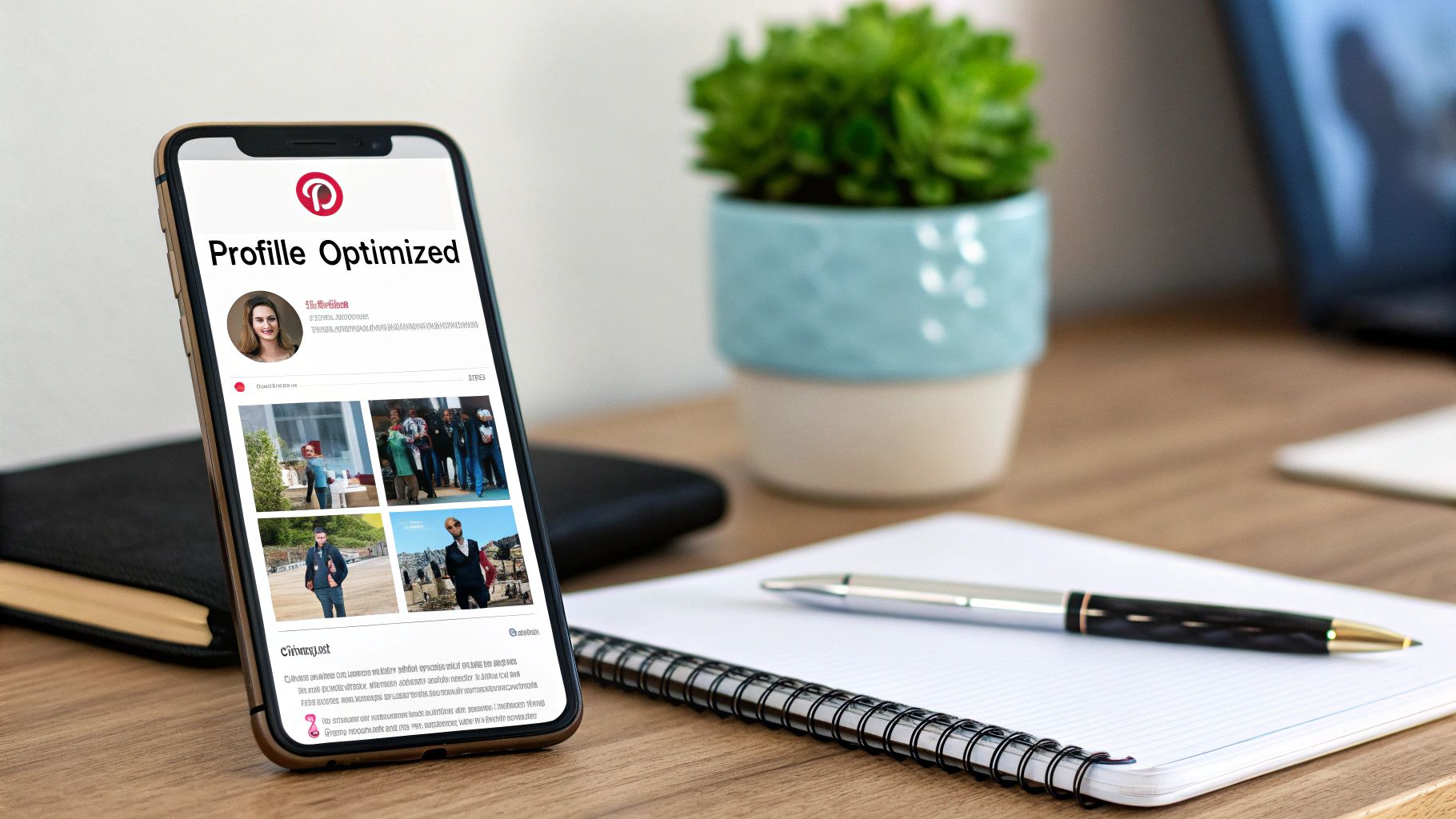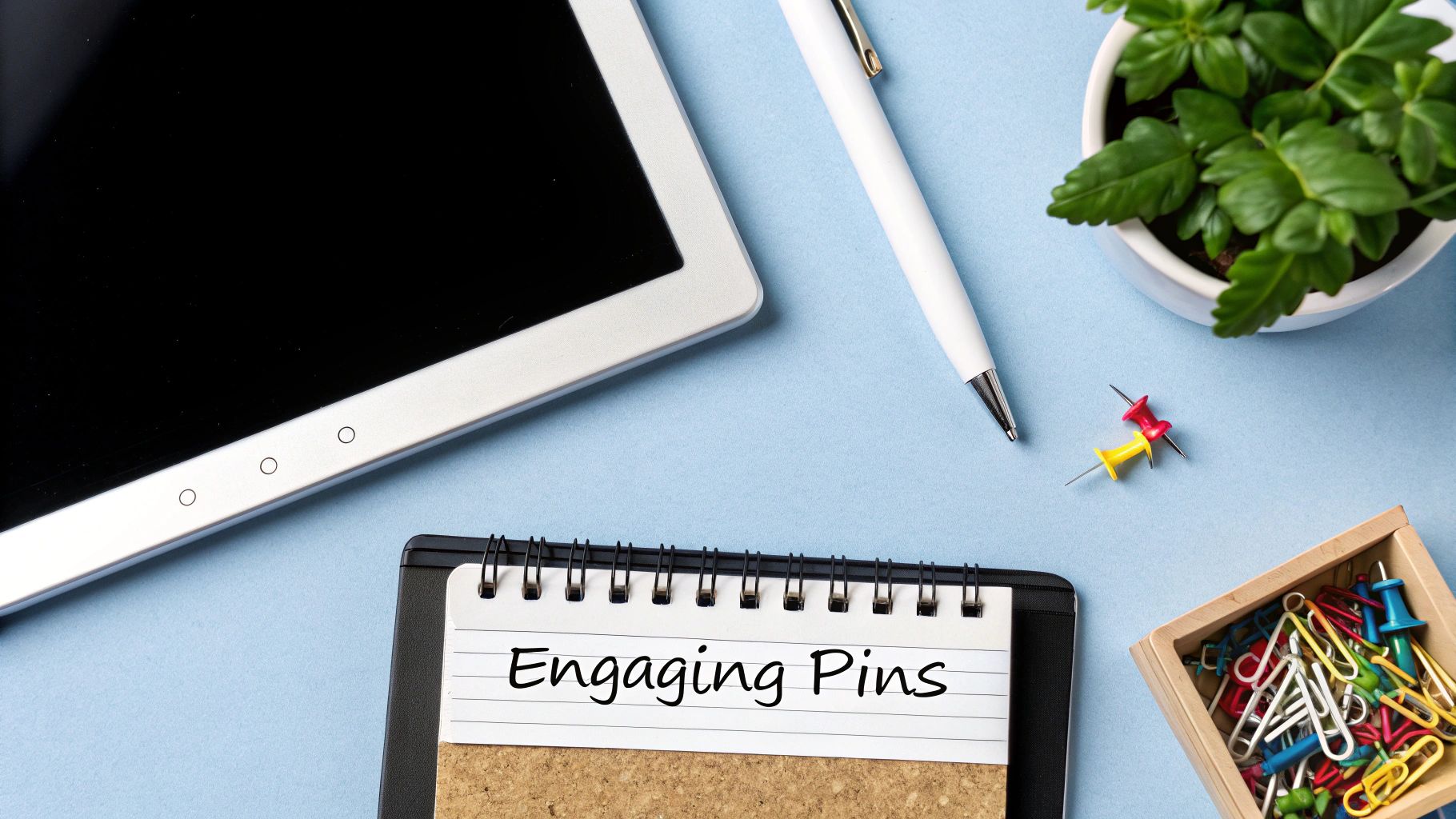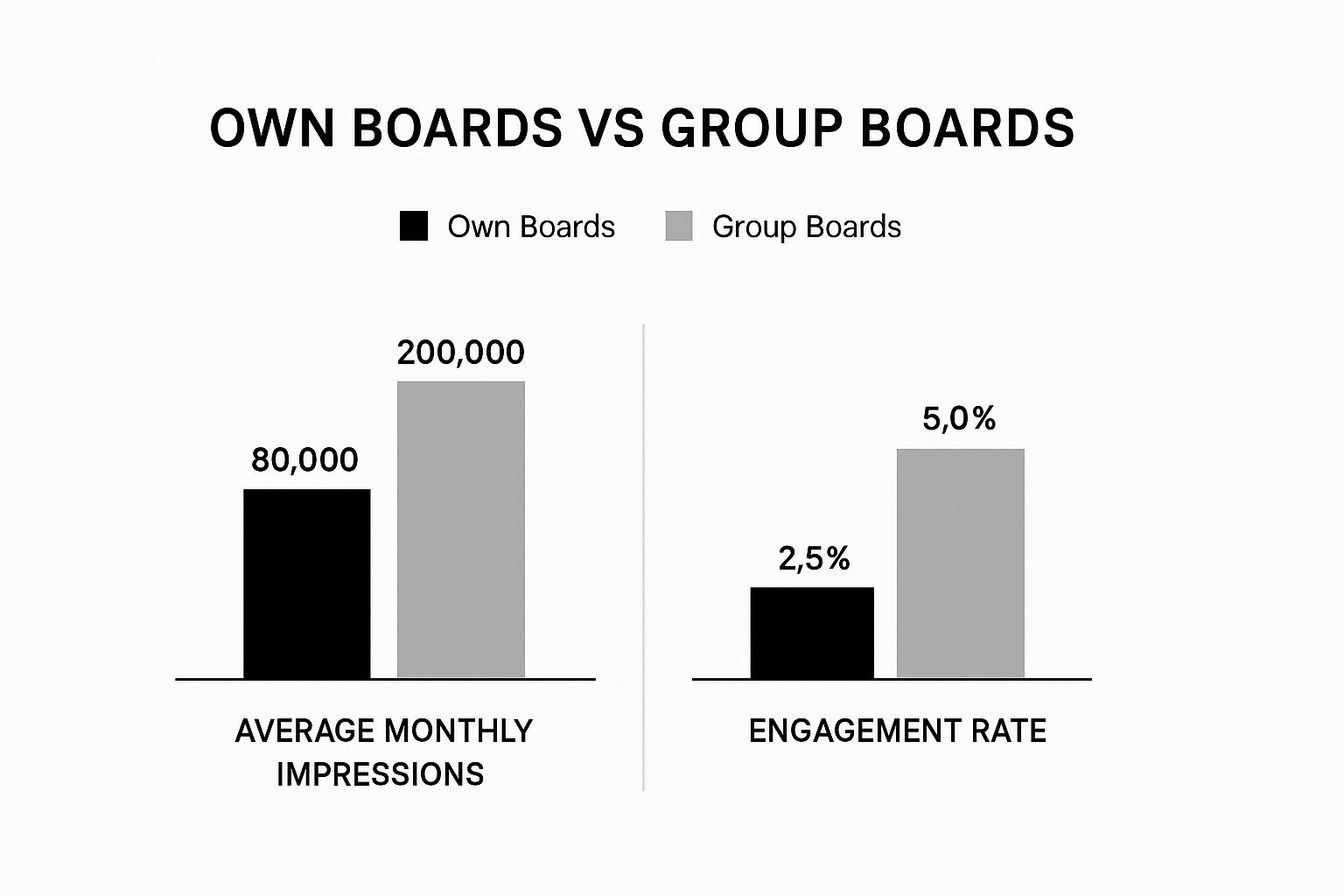Gain Pinterest Followers Fast: Proven Strategies to Grow
If you want to gain Pinterest followers, the first thing you need to do is stop thinking about it as a numbers game. Forget chasing vanity metrics. We're building a real, engaged community on a platform that's less like a social media feed and more like a visual search engine. Get this right, and you’ll see consistent website traffic, build genuine brand authority, and connect directly with people who are ready to buy.
Why Pinterest Followers Are More Than Just a Number

So many brands treat Pinterest like every other social platform, chasing quick likes and fleeting viral moments. That’s a huge mistake. It completely misses the point of why people are here in the first place. Users on Pinterest aren't just killing time; they're actively planning their lives, discovering new ideas, and making purchasing decisions.
A follower on Pinterest is a different breed entirely compared to someone who follows you on Instagram or Facebook. When someone follows you on Pinterest, they’re essentially subscribing to your future ideas. They’re telling you that what you share—whether it’s home decor inspiration, marketing strategies, or the latest fashion—is exactly what they’re looking for. This gives you a pre-qualified audience that's already interested in what you have to offer.
The Real Value Is in the Engagement
Your follower base is your built-in distribution engine. Every single time a follower saves one of your Pins to their boards, they’re showing it to their entire network. This is the magic of Pinterest—a ripple effect that can drive traffic to your content for months, sometimes even years, after you first hit publish.
Imagine this: you're a food blogger with 10,000 dedicated followers. You Pin a new recipe. Immediately, hundreds of your followers save it to boards like "Weeknight Dinners" or "Healthy Recipes." Just like that, your single Pin is now popping up in the feeds of thousands of new people who have the exact same interests. That organic reach is what helps your follower count grow exponentially.
Tying Follower Growth to Your Business Goals
To make your Pinterest efforts count, they have to be tied to clear social media marketing goals. It’s how you prove that followers are more than just a number on a screen. Every follower is a potential customer, a future blog reader, or a brand advocate in the making.
This direct link to commercial intent is Pinterest's superpower, especially as the platform keeps exploding in popularity. It's not just growing; its audience is getting younger and more mobile. By the first quarter of 2025, Pinterest had already hit 570 million monthly active users. Gen Z now makes up 42% of that global audience, and a staggering 82% of all pinning happens on mobile.
This isn't just growth; it's a massive opportunity. When you focus on attracting the right kind of followers—people who are genuinely into your niche—you’re building a powerful asset that pays off in tangible ways:
Creating a Profile That Pulls in Your Ideal Follower

Think of your Pinterest profile as your digital storefront. It’s the very first impression you make, and it can either draw people in or make them scroll right past. To effectively gain Pinterest followers, you have to stop seeing your profile as just a place for your name and start treating it as your most strategic asset.
When someone new lands on your page, they’re silently asking one question: "Is this for me?" You have about three seconds to give them a firm "yes." Every single element, from your username to your board titles, has to work together to grab the attention of your ideal follower and get them to hit that "Follow" button. Getting this foundation right is non-negotiable for any real growth.
Optimize Your Profile for Discovery
The journey to more followers starts long before anyone even lays eyes on your Pins. It begins with making your profile discoverable in the first place. At its core, Pinterest is a visual search engine, and optimizing your profile is how you tell its algorithm who you are and, more importantly, who it should show your content to.
Let’s start with your username. It should be professional, easy to remember, and as close to your actual brand name as possible. Ditch the complex numbers or symbols. A clean handle like "@PostPaddle" is instantly recognizable and simple for people to search. If your exact name is taken, try adding a relevant keyword, like "@YourBrandMarketing" or "@YourBrandDesigns."
Next up is your profile bio—this is prime real estate. You only have a few characters, so every single one needs to count. Clearly state who you are, what you do, and who you do it for. The key is to weave in your most important keywords naturally.
Finally, you absolutely need a Pinterest Business account to unlock the analytics and tools that drive real growth. If you haven't switched over yet, our guide on how to create a Pinterest Business account is a must-read. Claiming your website is a key part of this setup, as it gives you detailed insights into how your content is performing.
Craft Boards That Are Content Magnets
Your boards are the curated libraries that prove your expertise. Vague, generic board names like "Cool Stuff" or "My Faves" do absolutely nothing for your growth. This is one of the most powerful—and most overlooked—ways to gain Pinterest followers. Each board should be a hyper-focused collection of ideas built around a specific topic or keyword your audience cares about.
This targeted approach works on two levels:
When you're naming your boards, put yourself in your follower's shoes. What phrases are they typing into the search bar? Use those as your board titles.
Effective Board Naming Examples
Don't forget that each board also has a description. This is your chance to elaborate on the board's theme using related keywords and longer phrases. For that "Small Business Marketing Tips" board, you could add terms like "social media strategy," "content creation ideas," and "email marketing for entrepreneurs." This adds another layer of context for Pinterest, helping your content reach the right people and convincing them your profile is a valuable resource worth following.
Designing Pins That People Can't Resist Saving

On Pinterest, your Pins are your currency. They’re what stop the endless scroll and convince someone that your content is worth their time. A beautiful image is a great start, but a truly high-performing Pin is a carefully constructed blend of visuals, text, and strategy—all designed to attract saves and clicks.
Mastering Pin design is the cornerstone of any effort to gain Pinterest followers. When a Pin gets saved frequently, it sends a powerful signal to the Pinterest algorithm that your content has value. In turn, Pinterest shows it to more people, creating a positive feedback loop of discovery and growth. It all starts with one, well-designed image.
The Anatomy of a High-Performing Pin
Think of your Pin as a tiny, vertical billboard. You have a split second to grab someone’s attention and make your case. To make that moment count, every element needs to pull its weight.
Here’s what I’ve found works best:
For a deeper dive into the nitty-gritty of the creative process, our complete guide on how to create a Pin for Pinterest walks you through it step by step.
Choosing the Right Pin Format for Your Goal
Pinterest gives you a few different tools for the job, and knowing which Pin format to use is a huge strategic advantage. Standard Pins are the workhorse of any content plan, but don't sleep on Video and Idea Pins for boosting engagement.
Pin Format Breakdown
The move toward video on Pinterest is impossible to miss. What's fascinating is that 96% of top searches are unbranded, meaning users are there to discover new things—and video is a massive part of that exploration. Since users are 55% more likely to purchase after seeing video content, incorporating Video Pins is no longer optional if you're serious about growth.
Crafting Titles and Descriptions for Maximum Reach
The visual appeal of your Pin gets the initial look, but its title and description are what help it get found weeks and even months later. This is where all that keyword research you did really pays off.
Your Pin title needs to be direct and enticing. Weave in your main keyword, but frame it as a benefit for the user. Think like a magazine editor. Instead of a flat "Office Decor," a much stronger title is "10 Genius Small Home Office Ideas You Can Do This Weekend." See the difference?
The Pin description is your space to add more context and sprinkle in related keywords. Don't just list them; write naturally in full sentences, explaining what the user will find when they click.
For that home office Pin, a good description might include phrases like "space-saving desk solutions," "budget-friendly organization hacks," and "how to create a productive workspace." This approach ensures your Pin can be discovered from multiple angles, dramatically increasing its lifespan and its potential to bring you new followers.
Your Strategic Plan for Consistent Pinning
Consistency is the secret handshake with the Pinterest algorithm. It’s what tells the platform you’re a serious creator, turning your profile from a casual scrapbook into a valuable resource that deserves to be shown to more people. If you really want to gain Pinterest followers, you have to ditch the sporadic, "pin when I feel like it" approach and build a deliberate, sustainable rhythm.
This doesn't mean you need to be glued to your screen 24/7. Not at all. It's about creating a smart workflow that keeps your content fresh and your audience engaged without leading to burnout. You have two main paths to get there: pinning by hand or using an automation tool.
Manual Pinning vs. Automated Scheduling
Deciding how you'll publish your Pins is a big fork in the road. You can either do it all manually, in real-time, or schedule everything in advance. Both approaches have their place, and many successful creators I know use a bit of both. Let's break down what each one offers.
Here's a quick comparison to help you figure out which method—or hybrid model—best suits your style and growth goals.
Manual Pinning vs. Automated Scheduling
Manual pinning gives you that in-the-moment flexibility. You can react to a trending topic instantly or leave a thoughtful comment on another Pinner's content right as it's posted. It’s fantastic for genuine community building. The downside? It’s a massive time sink and becomes almost impossible to maintain once you start producing a lot of content.
Automation, on the other hand, is your key to consistency without the chaos. With tools like Post Paddle, you can design dozens of Pins in one creative burst and then schedule them to go live at the perfect times. This creates that seamless content drip that the algorithm loves. You get to focus on the big picture while your pinning runs on autopilot.
To take your efficiency even further, many top creators are now using AI marketing software to help with campaign ideation and performance analysis, which frees up even more of their time.
Finding Your Optimal Pinning Frequency
One of the first questions everyone asks is, "How often should I actually be pinning?" You'll see experts throw around numbers like 10 Pins a day, but the truth is, the perfect number depends entirely on your niche, your audience, and what you can realistically manage.
My advice? Forget the magic number and focus on a sustainable pace.
Posting 3-5 high-quality Pins every single day is far more powerful than dropping 15 Pins on a Monday and then going silent for a week. The algorithm rewards reliability, not just sheer volume.
Dive into your Pinterest Analytics to see when your audience is most active. Scheduling your Pins to go live during those peak windows can give them a crucial initial engagement boost, which is a major signal for long-term reach.
Balancing Your Content with Curated Value
A great Pinterest profile isn't just a megaphone for your own stuff. To become a true authority that people want to follow, you need to provide value beyond what you're selling. That’s where sharing content from other creators comes in.
I’ve always had success with the 80/20 rule. Aim for about 80% of your Pins to be your own content—linking to your blog, products, or services. The other 20% should be high-quality, relevant Pins from others in your niche.
This simple mix does two things: it shows your audience you’re here to help and inspire, not just to sell. It also helps you keep your boards active and full, even when you’re running low on your own content ideas.
This image breaks down the performance of Pins on your own boards versus group boards. It really drives home the importance of building up your own profile's authority.

As you can see, while group boards can give you a little extra reach, the real, lasting engagement comes from building strong, focused boards on your own profile. When you combine that with genuine community interaction, like commenting on other Pins, you cement your status as an expert worth following.
Using Pinterest Analytics to Fuel Your Growth
Posting great content is only half the battle. If you really want to scale your growth, you have to stop guessing what works and start letting data guide your decisions. This is where Pinterest Analytics becomes your secret weapon. Think of it as a direct feedback loop from your audience, turning you from a passive pinner into a strategic creator who knows exactly how to gain Pinterest followers.
It's easy to get overwhelmed by all the numbers, but you don't need to track every single metric. The real key is to focus on the data that directly influences follower growth. Forget the vanity metrics and zero in on what tells you what your audience truly loves and what makes them hit that "Follow" button.
Pinpointing Your Top-Performing Content
The blueprint for your future success is already waiting for you in your analytics dashboard. The first place I always check is my top-performing Pins and boards. This isn't just about spotting which Pins got the most views; it’s about digging deeper to understand why they took off.
Look for the patterns. Are your best Pins all short video tutorials? Do they share a specific color scheme or text overlay style? Maybe they all center on a particular sub-topic within your niche.
This data-driven approach is what separates the accounts that stall from the ones that see explosive growth. You learn what resonates, you do more of it, and you earn more followers. It’s that simple.
The Metrics That Actually Matter for Growth
To make your analysis truly effective, focus on the numbers that tell a clear story about how people are interacting with your content. From my experience, these are the core metrics you should be monitoring regularly:
By keeping an eye on these key indicators, you can quickly see what’s working and what isn’t. High impressions but low saves? Your visuals might be catching eyes, but the idea isn't compelling enough. High saves but low clicks? Your call-to-action on the Pin itself might need to be stronger. For more actionable advice on turning analytics into followers, check out our comprehensive guide to gain Pinterest followers.
Understanding Your Audience on a Deeper Level
Don't sleep on the "Audience Insights" tab—it’s a goldmine for creating hyper-relevant content. This section gives you a detailed breakdown of your followers' demographics, their other interests, and even the other brands they follow.
Imagine you’re a food blogger and you discover that a huge chunk of your audience is also interested in "sustainable living." You can immediately start planning a new board and content series around eco-friendly kitchen tips, knowing you have a built-in audience ready to engage. This is how you make your profile feel like an indispensable resource they can’t afford not to follow.
This deep understanding is crucial because Pinterest is a commercial powerhouse. It delivers 33% more referral traffic to shopping sites than Facebook does, proving its ability to turn inspiration into sales. When you know who your audience is and what they care about, you can position your content to meet their needs and drive real results. It’s no wonder the platform achieves a 32% higher ROAS than other social channels.